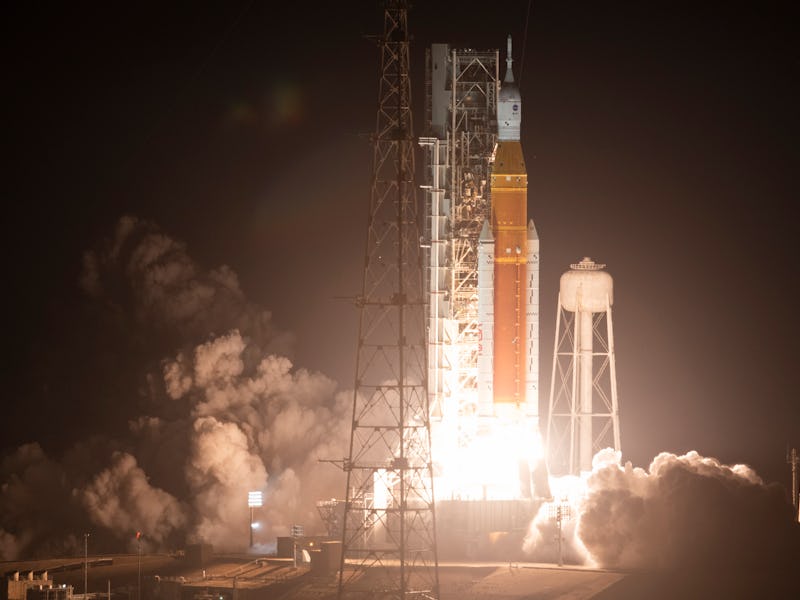Artemis: NASA's Historic Moon Launch Caused More Noise Pollution Than Expected
The audacious mission rumbled the surrounding area more than we knew.

The Space Launch System (SLS) that blasted the Artemis 1 mission on its historic mission to the Moon produced more noise than predicted. This is according to data from microphones placed across NASA’s Kennedy Space Center in Cape Canaveral, Florida ahead of the rocket’s November 2022 nighttime launch.
Kent Gee is a professor of Physics at Brigham Young University who studies “anything that produces high-amplitude noise.” To that end, Gee investigates rocket noise, which can be intense enough to risk damage to the rocket itself, to the launchpad, to the payloads onboard the vehicle, as well as impact wildlife and the people living in communities closeby. A document published Tuesday in JASA Express Letters details what Gee’s team found 12 days after the historic launch of the most powerful rocket to ever fly.
A single sonic event is packed with crackles, booms, thumps and rumbles — and its effects are not well understood, Gee emphasizes to Inverse. Noise radiation will be essential to understand in all its complexities as launches happen more frequently — a possibility if the commercial spaceflight sector continues to grow — and as rocketry expands to more places around the world.
Crackles and rumbles
Gee says that from a little more than three miles away, Artemis 1 sounded like a chainsaw next to your ear. Or in breakfast terms, the letter published Tuesday says “we dryly observe that the weighted SLS noise intensity at Station 4” — a location roughly the same distance from the rocket as where press was standing — “is approximately 40 million times greater than a bowl of audible morning cereal.”
There’s a spectrum of sound in a rocket launch. The ear senses different phenomena and interprets them as crackles, booms, rumbles and thumps. The noise can also be felt.
You’ve probably heard the rumble of a plane. The bulk of the sound, Gee says, is the air turbulence the plane creates with its enormous plume. “But a rocket is so much bigger than, let’s say, an aircraft, and that exhaust plume is faster and hotter, and so it produces more noise and a lot lower frequency noise simply because of the scale of it … that’s where the rumble comes from,” Gee says.
The launch ripped apart the elevator tower for Artemis I.
Crackles are heard when low acoustic pressure escalates to a high one in a very short period of time. This shock creates random turbulence and the rapid succession of sound.
Fortunately, sound decays quickly, Gee says. And as the rocket flies away from you, eventually the crackle starts to sound more like a “boom boom, thump thump.”
But it’s not clear yet what these gargantuan sonic events could do to people and wildlife, and how they will respond.
After the sonic shock
As rockets get more powerful, their noise radiation could grow bigger. Even a single launch might risk a major disturbance, Gee says.
Gee wants to explore how sound radiation from rockets could harm wildlife that settle in the largely-isolated land around launchpad, especially birds. Gee cited the flocks seen in footage from SpaceX’s recent major test of its heavy-lift rocket, Starship.
Gee also says it’s important to learn how the noise could damage older buildings and the mobile support structures that service the rockets.
Louder than expected
Gee’s team found that the ignition overpressure was particularly intense and propagated towards the north. Located there is Canaveral National Seashore, which the National Park Service website describes as a “prime habitat for many threatened and endangered species,” which includes providing nesting beaches for marine turtles.
From two kilometers away, the rocket launch created 140 decibels of noise. Gee described that level of noise as what you’d hear being 100 feet away from a Boeing 747.
Gee’s microphones, placed at different locations near or within Kennedy Space Center, found that the rocket was louder than expected. “The sound level they predicted actually occurred twice as far as their prediction distance,” Gee says.
“I’m not saying NASA did anything wrong… we don’t know what the causes are,” he adds. Local weather, being upwind or downwind, humidity, and time of day can all have an effect on the noise.
Sound is complicated
Improved models are necessary to understand what the noise radiation will be from rockets of all sizes.
“Sound is complicated,” Gee says. To that end, the future of rocket acoustic research might include investigations into how the rocket vehicle produces noises, why at those frequencies and sound levels, and why they change as the rocket moves away from the launchpad into space.
This article was originally published on